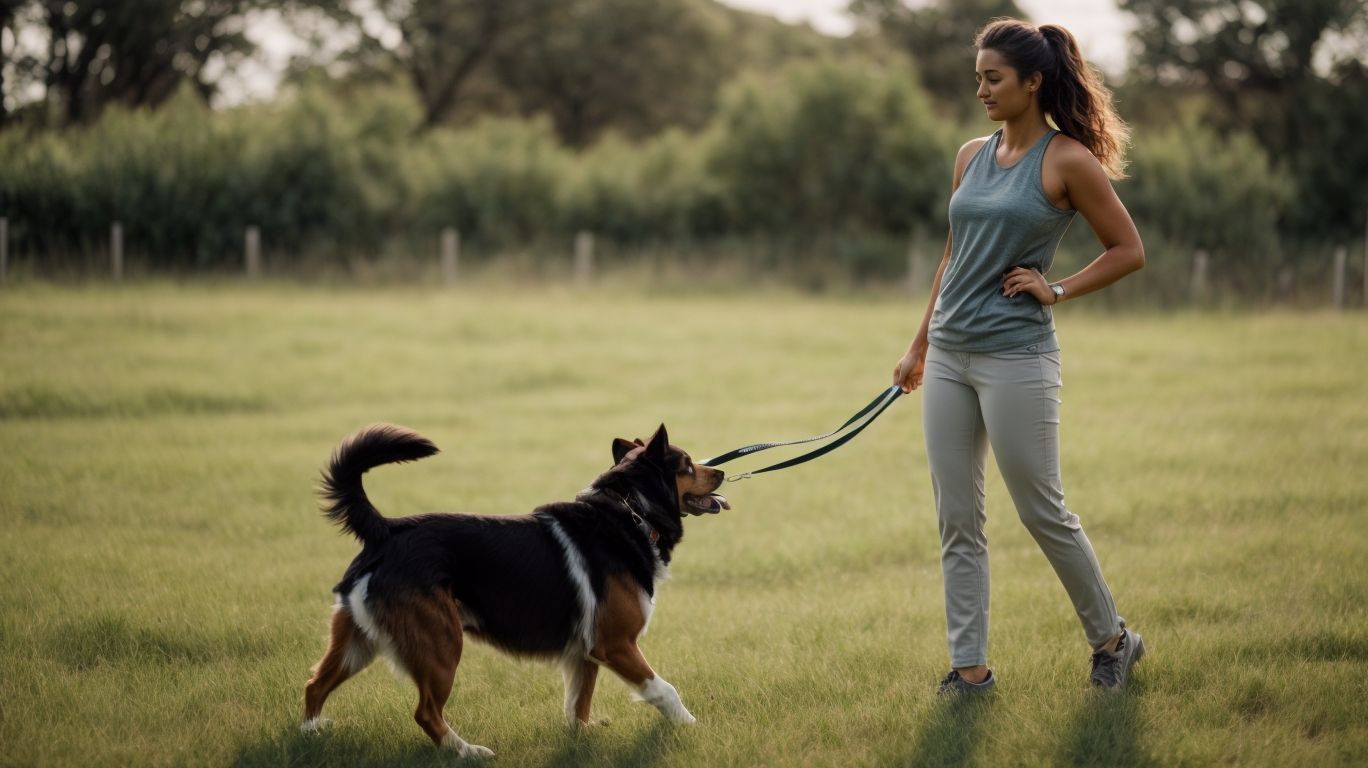
The Psychology Behind Dog Training: Understanding Canine Submissiveness
The key to successful dog training lies in understanding the psychological factors that influence a dog’s behavior. One such crucial aspect is canine submissiveness, which plays a significant role in shaping a dog’s responses to training techniques. In this comprehensive guide, we will delve into the concept of canine submissiveness, exploring its causes, effects on training, and methods to address it. By gaining a deep understanding of this phenomenon, dog owners and trainers can build stronger relationships with their furry companions, employ more effective training methods, and gain valuable insights into their dog’s behavior.
Read on to unlock the psychology behind dog training and discover the significance of understanding canine submissiveness.
What Is Canine Submissiveness?
Canine submissiveness refers to a dog’s behavior of yielding to a more dominant individual or following the commands and cues of a more assertive or authoritative figure in its social group.
This behavior is deeply rooted in the psychological and behavioral aspects of dogs, often stemming from their innate pack mentality. In the wild, social hierarchy is crucial for survival, and dogs have retained this instinct in their interactions with humans.
Understanding canine submissiveness is vital in dog training; utilizing positive reinforcement techniques can encourage desired behaviors while respecting the dog’s natural tendencies. By acknowledging and working with a dog’s submissive nature, owners and trainers can strengthen the bond with their canine companions and foster a harmonious social hierarchy.
What Are The Causes Of Canine Submissiveness?
There are several factors that contribute to canine submissiveness, including genetics, early life experiences, and specific training techniques that influence a dog’s behavior and social interactions.
Genetics
Genetics plays a significant role in determining a dog’s predisposition towards submissiveness or assertiveness, as certain breeds may exhibit inherent traits linked to submissiveness.
These genetic factors can influence a dog’s natural instincts and behaviors, impacting their response to social interactions and training. For example, some breeds, such as Golden Retrievers and Labrador Retrievers, are known for their friendly and submissive nature, while others like the Shiba Inu may display more independent and assertive tendencies.
Understanding these breed predispositions can help owners and trainers tailor their approach to effectively guide and support their dogs in developing desirable behaviors.
Early Life Experiences
The early life experiences of a dog, including socialization, training methods, and environmental factors, can significantly influence the development of submissive or dominant behaviors.
These formative experiences play a crucial role in shaping a dog’s temperament and behavior patterns. Positive socialization with humans and other animals during the critical developmental period can lead to a well-adjusted and sociable pet. Conversely, inadequate socialization or exposure to negative stimuli may result in fearfulness, aggression, or other behavioral issues.
The training methods employed during puppyhood can impact a dog’s receptiveness to commands and their overall obedience. The environmental factors, such as living conditions and interactions with the surroundings, also contribute to the dog’s behavioral development.”
Training Techniques
The training techniques employed by dog owners and trainers significantly impact a dog’s behavior and their tendency towards submissiveness or assertiveness, emphasizing the importance of effective and balanced training methods.
Positive reinforcement, such as using treats or praise to reward desired behaviors, has been found to be highly effective in fostering a submissive and obedient attitude in dogs. Leash training plays a crucial role in teaching dogs how to follow commands and respect their owner’s leadership.
Clear communication through consistent training cues further enhances a dog’s understanding and compliance, creating a harmonious relationship between the dog and its owner.
How Does Canine Submissiveness Affect Dog Training?
Canine submissiveness can have significant effects on the training process, impacting a dog’s ability to learn new tasks, their responses to fear and anxiety, and the potential for aggressive behaviors in certain situations.
It is important for dog trainers and owners to understand how submissiveness can contribute to stress and communication issues in dogs. Dogs that are overly submissive may struggle to assert themselves or communicate effectively, leading to heightened levels of stress and anxiety. This can hinder the learning process, as the dog may become overwhelmed or shut down when faced with challenging tasks.
Submissiveness can also play a role in fear-based aggression, as the dog may feel compelled to act defensively in situations where they feel threatened or insecure.
Difficulty In Learning New Tasks
Canine submissiveness may manifest as a challenge for dogs to grasp and execute new tasks, as they may struggle with interpreting social cues, responding to commands, and displaying initiative in learning processes.
This submissiveness can hinder a dog’s ability to understand and respond appropriately to social cues, leading to difficulties in recognizing signals from other animals or humans. Learning commands can also pose a challenge, as submissive dogs may feel timid or hesitant to take action without clear guidance. Their lack of initiative in learning processes may result in slower progress in acquiring new skills, making it important for trainers to understand and address these obstacles in the context of learning theory and canine instincts.
Fear And Anxiety
Submissive tendencies in dogs can contribute to heightened levels of fear and anxiety, leading to potential behavioral problems and challenges in effectively addressing and managing their emotional responses.
This correlation emphasizes the importance of implementing desensitization and counterconditioning techniques, as well as effective socialization practices, to help dogs overcome their fear and anxiety. By gradually exposing them to the source of their stress in a controlled environment and associating positive experiences, we can help them build resilience and reduce their submissive behaviors.
Through consistent training and positive reinforcement, we can reshape their response patterns, ultimately promoting a more confident and balanced demeanor in various social interactions.
Aggressive Responses
While submissive behavior is often associated with non-aggressive responses, it can also lead to reactive aggression in dogs when they feel threatened, challenged, or overwhelmed, necessitating careful management of their behavioral reactions.
This form of aggression can stem from a sense of fear or insecurity, causing the dog to lunge, growl, or even bite as a way of self-protection. It’s essential for dog owners to address this behavior promptly through behavior modification techniques and socialization.
By understanding the social cues that trigger these responses, owners can help their dogs feel more secure and confident, reducing the likelihood of reactive aggression. Consistent training and positive reinforcement can play a significant role in redirecting this learned behavior towards more appropriate responses.
What Are The Signs Of Canine Submissiveness?
Recognizing the signs of canine submissiveness is vital for understanding a dog’s behavior, as these signs may include:
- cowering and avoidance
- tail tucking
- submissive urination
each reflecting the dog’s emotional responses and social cues.
These visible manifestations of submissiveness also encompass lowered body posture, ears held back, and averted gaze, signaling an attempt to appease or avoid conflict. Submissive behaviors like licking, mouthing, and rolling over can be observed during interactions.
Understanding these instinctual responses can aid in effective leash training and building trust in social settings, facilitating a harmonious relationship between dogs and their human companions.
Cowering And Avoidance
Cowering and avoidance behaviors in dogs are often indicative of submissiveness, reflecting the dog’s attempt to avoid conflict or assert dominance, and showcasing the impact of their learned and instinctual behaviors.
These behaviors are deeply rooted in the dog’s social nature, as they are influenced by their instinctual understanding of pack dynamics. Dogs may cower or avoid certain situations as a way to communicate deference to a more assertive or dominant individual within the social group. Body language and social cues play a significant role in these behaviors, as dogs use subtle signals to convey their submissive stance and avoid potential confrontations.
Understanding these behaviors can provide valuable insights into animal psychology and help in creating harmonious interactions between humans and their canine companions.
Tail Tucking
The act of tucking their tail between their legs is a common sign of submissiveness in dogs, demonstrating their response to perceived threats or displays of dominance within their social environment, reflecting their innate and learned behavioral patterns.
This behavior is deeply rooted in the intricate dynamics of pack hierarchy and animal psychology. When a dog tucks its tail, it is a clear indication of yielding to a perceived authority figure, an instinctual response honed through generations. Understanding this body language is crucial for effective communication with our canine companions, as it allows us to discern their emotional state and respond appropriately to their social cues.
Urination
Submissive urination is a common behavior displayed by dogs, often in response to social interactions, perceived threats, or as a form of appeasement, highlighting the influence of their instinctual and learned behaviors in such situations.
This behavior is deeply rooted in pack dynamics, where the dog’s instinct to submit to a more dominant member is evident. Social cues from humans or other animals can trigger submissive urination. Understanding the psychology behind this behavior is crucial, as it reflects the dog’s attempt to avoid conflict and maintain harmony within the social group.
Owners can help manage submissive urination by utilizing positive reinforcement, building the dog’s confidence, and creating a supportive and reassuring environment.
How Can Canine Submissiveness Be Addressed?
Addressing canine submissiveness involves employing positive reinforcement training methods, building confidence and trust in the dog, and avoiding the use of punishment-based techniques that can exacerbate stress and anxiety.
Positive reinforcement training methods, such as clicker training and treats, can encourage the desired behaviors in a submissive dog.
Confidence-building exercises, including agility training or interactive games, can help the dog feel more secure in their environment.
Desensitization techniques, such as gradually exposing the dog to the trigger of their submissive behavior in a controlled and positive manner, can reduce their stress response.
Socialization with other dogs and people in a safe and supportive setting can improve the dog’s overall confidence and reduce submissive tendencies.
Positive Reinforcement Training
Positive reinforcement training techniques are pivotal in addressing canine submissiveness, as they foster motivation, attention, and impulse control while strengthening the bond and trust between the dog and its owner or trainer.
By utilizing positive reinforcement, dogs are more likely to exhibit desired behaviors, leading to a stronger sense of trust and collaboration. This approach not only encourages obedience but also enhances the dog’s overall well-being.
Through positive reinforcement, dogs associate good behavior with rewards, which boosts their motivation to repeat those actions. It helps in establishing clear communication between the dog and the trainer, creating a positive and respectful relationship.
Building Confidence And Trust
Building a dog’s confidence and trust is essential in mitigating submissiveness, as it promotes a sense of security, independence, and assurance, fostering a more balanced and stable behavior in social interactions.
This can be achieved through various strategies, such as consistent positive reinforcement, providing clear and consistent leadership, and engaging in mental stimulation activities. By focusing on attention and rewarding desirable behaviors, dogs learn to trust and rely on their owners, which consequently enhances their socialization skills and facilitates stronger bonds.
Involving them in interactive play, training, and exposing them to new experiences can help build their confidence, enabling them to navigate different environments with ease.
Avoiding Punishment-Based Techniques
Avoiding the use of punishment-based techniques is crucial in addressing canine submissiveness, as such methods can create stress, anxiety, and exacerbate behavioral problems, hindering the dog’s overall development and well-being.
Instead, focusing on building trust through positive reinforcement and socialization can help in establishing a stronger bond between the dog and its owner. By encouraging desired behaviors and using rewards, the dog learns to better understand what is expected of it, leading to a more harmonious relationship.
Punishment-based techniques can instill fear and erode the trust essential for effective behavior modification, potentially escalating submissive or aggressive behavior in the long run.
What Are The Benefits Of Understanding Canine Submissiveness?
Understanding canine submissiveness brings several benefits, including an improved relationship with the dog, more effective training methods, and a better comprehension of the dog’s behavioral responses and social dynamics.
When a dog’s submissive behavior is recognized and respected, it fosters a sense of trust and security in the relationship between the owner and the pet. This, in turn, can result in a more cooperative and responsive attitude from the dog during training sessions.
Being able to interpret submissive gestures and signals can assist in preventing or addressing problem behaviors while enhancing the learning process for both the dog and the owner.
Improved Relationship With Your Dog
Understanding and managing canine submissiveness fosters a stronger bond and trust between the owner or trainer and the dog, enhancing the overall quality of the relationship and communication dynamics within the human-canine partnership.
This positive impact stems from the consistent reinforcement of desired behaviors, which not only addresses problem behavior but also reinforces a sense of security and confidence in the dog. Through effective communication and praise, the dog learns to trust its owner and responds positively to training, leading to a harmonious and fulfilling relationship.
By incorporating principles from learning theory, addressing submissiveness can transform the dynamics of the relationship, establishing a basis of mutual respect and understanding.
More Effective Training Methods
Comprehending canine submissiveness allows for the implementation of more tailored and effective training techniques, promoting learning, cooperation, and the resolution of problem behaviors with a focus on positive reinforcement and trust-building strategies.
Understanding the concept of submissiveness in dogs ensures that trainers can adapt their methods to suit individual personalities and behavioral patterns. By emphasizing positive reinforcement, such as offering praise, treats, or toys for desired behavior, trainers can cultivate a sense of obedience and willingness to learn in their canine companions.
Incorporating learning theory and understanding the significance of reinforcement in training contributes to more harmonious interactions and a deeper bond between dogs and their owners.
Better Understanding Of Your Dog’s Behavior
Understanding canine submissiveness provides insights into a dog’s behavioral responses, social dynamics, and the underlying motivations guiding their actions, enabling more effective and empathetic interactions based on trust and respect.
This understanding is essential for addressing problem behaviors and nurturing positive relationships with dogs. By recognizing submissive signals, such as lowering the head or body, avoiding direct eye contact, or offering appeasement behaviors, owners and trainers can respond appropriately, avoiding unnecessary confrontations and building trust.
Incorporating learning theory principles, such as positive reinforcement and mental stimulation, provides a constructive approach to shaping desired behaviors, fostering a supportive environment for the dog’s growth and development. Instead of focusing on dominance or punishment, emphasizing leadership through clear communication and consistent training techniques can yield long-term behavioral improvements.




No Comments